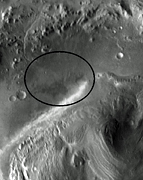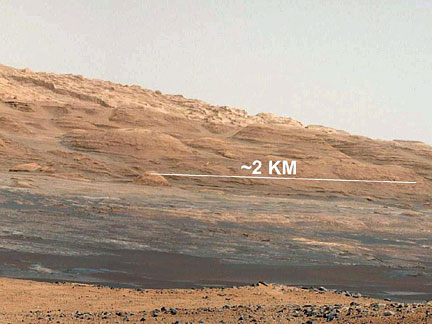“Dare Mighty Things” — Theodore Roosevelt
"Curiosity is the passion that drives us
through our everyday lives. We have become explorers and scientists with
our need to ask questions and to wonder."
— Clara Ma, a sixth-grader from Kansas, who submitted the winning suggestion fof NASA's contest to name the new Mars rover.
I was delighted to attend the first
public presentation on the start of Curiosity’s science mission on Mars,
part of Caltech’s Space Exploration alumni conference. The speakers
included Charles Elachi, Director of JPL, and John Grotzinger, Project
Scientist of Mars Science Laboratory (aka “Curiosity”). It was a glorious day for Caltech/JPL — a “techer” love-fest.
Tens of millions of people watched and waited through “Seven Minutes of Terror” as Curiosity flawlessly executed the most complex landing ever attempted. Crowds worldwide jubilantly cheered when Curiosity
safely touched down within its 12 mile-long target zone, only 1.5 miles
from target center, after a 350 million-mile journey from Earth. New
Yorkers in Times Square cheered “NASA, NASA, NASA…” As Dr. Elachi
remarked,” when have you heard a crowd cheering for a government agency?”
For all those enthralled by space exploration, Curiosity
may be the greatest leap for mankind since Neil Armstrong set foot on
the moon 43 years ago. Armstrong dared the mightiest; we mourn his
passing.
Caltech astronomer Mike Brown noted at
this conference that half of all Americans today were born after the
last moon landing (Apollo 17, December 1972). For them, men walking on
the moon is merely history — they never had the exhilarating feeling of
our achieving together such an incredible feat.
Now that Curiosity has safely landed and passed extensive system checkouts, what is the next step?
The landing site is ideal for
exploration. Gale Crater (named for Australian astronomer Walter Gale)
is perfectly situated along Mars’ “Dichotomy Boundary”, between the
younger and lower northern plains and the older southern highlands.

Since water runs downhill, any surface
water that may have previously existed would have drained across the
Dichotomy Boundary, and much of that would have collected in Gale
Crater, one of the region’s lowest points.
The crater floor is 14,000 feet below
Mars’ average surface elevation (Grand Canyon is 6,000 feet deep).
Remote analyses from prior Mars orbiters show that Gale Crater contains
clays and sulfates that are believed to form only in the presence of
water.
In the center of Gale Crater, Mt. Sharp
(named for Robert Sharp - former head of Caltech’s geology department),
rises 18,000 feet above the crater floor (Mt. McKinley rises 18,000 feet
above its average base and Mt. Everest rises 14,000 feet above the
Tibetan Plateau). Fortunately, Mt. Sharp’s gradual slopes will be much
easier to climb than those Earthy peaks.
Geologists believe the past is written in
the rocks. Just as the exposed layers of the Grand Canyon tell the tale
of Earth’s past, so we believe the slopes of Mt. Sharp will reveal
Mars’ past — its climate and geologic history, and if and when there was
water that may have supported some elementary forms of life.
The overhead view seen below shows the elliptical targeted landing zone near the base of Mt. Sharp.

Slightly above and to the left is a
jagged white line that is possibly the remains of an ancient river that
drained into Gale Crater. This “river” may have produced the triangular,
light gray area in the left side of the landing ellipse that resembles
sedimentary deposits called “alluvial fans” that are common in Earth’s
canyons. The bright white diagonal streak in the landing ellipse’s
lower right is the flank of Mt. Sharp.
The next picture shows this flank of Mt.
Sharp, viewed from the surface and imaged by Curiosity. This is the
region rich in clays and sulfates that Curiosity will ultimately
explore. It should need to climb only 700 feet to examine the most
promising terrain.

But before starting its long journey to Mt. Sharp, Curiosity will explore some intriguing nearby sites.
Thermal imaging shows that Curiosity has landed near a “triple junction”, where regions of three different compositions meet. Curiosity’s scientific instruments were designed for exactly such opportunities.
A full chemistry lab is packed into Curiosity’s
microwave-oven-sized box that weighs 180 pounds and cost $90 million.
The instruments include a mass spectrometer, a gas chromatograph, a
tunable laser spectrometer, an alpha particle x-ray spectrometer, and
x-ray diffraction spectrometer, a neutron emission detector, and a
full-spectrum radiation detector.
Curiosity can dig, scoop, and
drill for material to analyze, but it can also do so remotely. It can
use its laser to blast rocks over 20 feet away, and then analyze the
vaporized rock to determine its atomic composition. The first such
analysis has already been done on a rock dubbed “Coronation.”
Curiosity’s primary mission will last one Martian year (687 Earth days).
It will be a marvelous adventure.
"We shall not cease from exploration, and
the end of all our exploring will be to arrive where we started and
know the place for the first time." — T.S. Eliot
Best Regards,
Robert
August 28, 2012
Note: Previous newsletters can be found on my website.
|